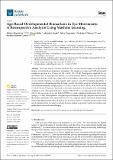Age-Based Developmental Biomarkers in Eye Movements: A Retrospective Analysis Using Machine Learning
Author(s)
Hunfalvay, Melissa; Bolte, Takumi; Singh, Abhishek; Greenstein, Ethan; Murray, Nicholas P.; Carrick, Frederick Robert; ... Show more Show less
Downloadbrainsci-14-00686-v2.pdf (1.463Mb)
Publisher with Creative Commons License
Publisher with Creative Commons License
Creative Commons Attribution
Terms of use
Metadata
Show full item recordAbstract
This study aimed to identify when and how eye movements change across the human lifespan to benchmark developmental biomarkers. The sample size comprised 45,696 participants, ranging in age from 6 to 80 years old (M = 30.39; SD = 17.46). Participants completed six eye movement tests: Circular Smooth Pursuit, Horizontal Smooth Pursuit, Vertical Smooth Pursuit, Horizontal Saccades, Vertical Saccades, and Fixation Stability. These tests examined all four major eye movements (fixations, saccades, pursuits, and vergence) using 89 eye-tracking algorithms. A semi-supervised, self-training, machine learning classifier was used to group the data into age ranges. This classifier resulted in 12 age groups: 6–7, 8–11, 12–14, 15–25, 26–31, 32–38, 39–45, 46–53, 54–60, 61–68, 69–76, and 77–80 years. To provide a descriptive indication of the strength of the self-training classifier, a series of multiple analyses of variance (MANOVA) were conducted on the multivariate effect of the age groups by test set. Each MANOVA revealed a significant multivariate effect on age groups (p < 0.001). Developmental changes in eye movements across age categories were identified. Specifically, similarities were observed between very young and elderly individuals. Middle-aged individuals (30s) generally showed the best eye movement metrics. Clinicians and researchers may use the findings from this study to inform decision-making on patients’ health and wellness and guide effective research methodologies.
Date issued
2024-07-09Department
Massachusetts Institute of Technology. Department of Biological EngineeringJournal
Brain Sciences
Publisher
MDPI AG
Citation
Hunfalvay, M.; Bolte, T.; Singh, A.; Greenstein, E.; Murray, N.P.; Carrick, F.R. Age-Based Developmental Biomarkers in Eye Movements: A Retrospective Analysis Using Machine Learning. Brain Sci. 2024, 14, 686.
Version: Final published version
ISSN
2076-3425